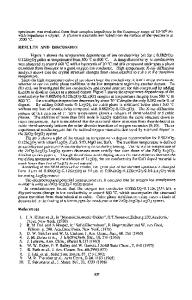Spinel-corundum equilibria and activities in the system MgO-Al 2 O 3 -Cr 2 O 3 at 1473 K
- PDF / 388,192 Bytes
- 10 Pages / 612 x 792 pts (letter) Page_size
- 60 Downloads / 292 Views
NTRODUCTION
RECENTLY several attempts have been made to produce crude molten stainless steel by direct smelting of ironchromium ore in a basic oxygen furnace (BOF), without the use of ferrochromium alloys, in order to save electrical energy and reduce the cost of production.[1–4] Some fundamental studies on the reduction rate of solid chromium ore and kinetics of smelting reduction of chromium ore by carbonaceous materials have been conducted.[5–9] However, there is limited thermodynamic data on the complex ores used. For a better understanding of the new process, especially the reduction stage, it is useful to have good data on the starting material. It is known that iron-chromium ore generally consists of a spinel solid solution containing Fe3O4, FeAl2O4, FeCr2O4, MgAl2O4, and MgCr2O4. Since Fe3O4 in the ore can be easily reduced by solid carbon or reducing gas, iron-chromium ore after initial reduction is essentially a spinel solid solution (Fe,Mg)(Al, Cr)2O4. The solid solution on further reduction can give a mixture of Fe-Cr alloy, a spinel solid solution Mg(Al,Cr)2O4, and a sesquioxide solid solution (Al,Cr)2O3. As a part of systematic studies on the complex spinel solid solutions, measurements have been made on the system MgO-Al2O3-Cr2O3 at 1473 K. Tie-lines connecting the spinel solid solution MgAl2O4-MgCr2O4 and the corundum solid solution Al2O3-Cr2O3 were determined experimentally. The activities and mixing properties of the spinel solid solution K.T. JACOB, Professor, Department of Metallurgy and Materials Researcher Center, and C.K. BEHERA, Graduate Student, Department of Metallurgy, are with the Indian Institute of Science, Bangalore, 560 012, India. Manuscript submitted November 29, 1999.
METALLURGICAL AND MATERIALS TRANSACTIONS B
are derived from the tie-line data. In earlier studies,[10,11] activities in the spinel solid solution FeAl2O4-FeCr2O4 have been measured as a function of temperature and composition using electromotive force and phase equilibrium techniques. The main contributions to the Gibbs energy of mixing are the configurational entropy from mixing of cations on tetrahedral and octahedral sites and strain enthalpy due to size difference between Al31 and Cr31 ions. More recently, activities of the constituents in the FeAl2O4-MgAl2O4 and FeCr2O4-MgCr2O4 solid solutions were investigated using a solid-state cell in the temperature range 1100 to 1350 K.[12,13] Mild negative deviations from Raoult’s law were observed. The mixing properties for both systems were adequately represented by a regular solution model. Values of the regular solution parameter, defined by V 5 DH/X(1 2 X ) 5 DGE/X(1 2 X ), are 21.9 (60.17) kJ mol21 for the FeXMg12XAl2O4 solid solution and 22.26 (60.20) kJ mol21 for the FeXMg12XCr2O4 solid solution. The thermodynamic behavior of the two solid solution series is mainly influenced by mixing of the divalent cations on the tetrahedral sites. The activity of MgCr2O4 in the spinel solid solution MgAl12XCrXO4 was measured by Morita et al.[14] by equilibrating the solid sol
Data Loading...











